Introduction by Dr Phill Pullinger, Kuno Director and CEO:
Cat grew up on the shores of Loch Ness, and from the very earliest of ages her parents ran a garden and nursery infused her with the names of a myriad of botanical plants and aspects of the natural history around her. So, as she grew up she threw herself into the outdoors and became a Nature tour guide.
When she came to Australia, she kept hearing again and again the name of Inala. So she proactively sought out Inala, which brought her here to her home on Bruny Island, where she guides tours with Inala and also across the world. She’s going to talk about the importance of connection to Nature. Thanks Cat.
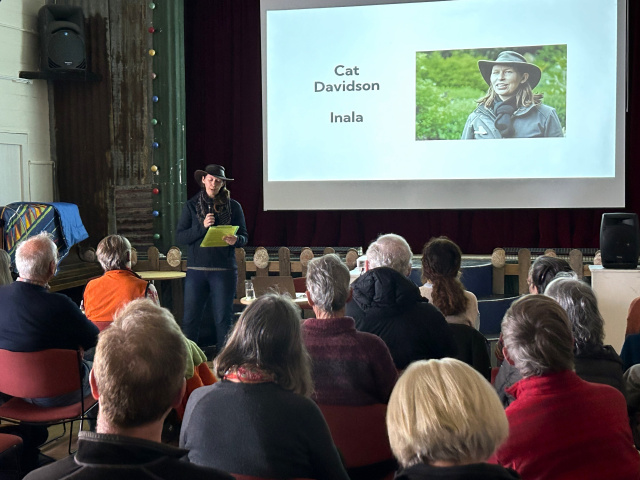
Cat Davidson: It’s an honour to stand before you today to discuss an issue at the very heart of our very future – the connection between Bruny Islanders and the natural world they inhabit. Bruny Island, with its unique biodiversity, is not just a place of beauty. It’s a living testament to the resilience and fragility of Nature.
Connecting Bruny Islanders to a deep love of Nature is not merely an act of appreciation, but a crucial step towards ensuring the island’s long-term protection.
As First Lady and environmentalist, Lady Bird Johnston famously said “the environment is where we all meet. We all have a mutual interest. It is the one thing we all share.” This perspective is very relevant to Bruny Island, where every tree and every stretch of coastline and every species of wildlife is part of the delicate web of life that needs our protection.
This island’s breathtaking landscapes are not merely for our enjoyment, they are crucial to our ecological health, our physical and mental wellbeing and for many, our economic stability.
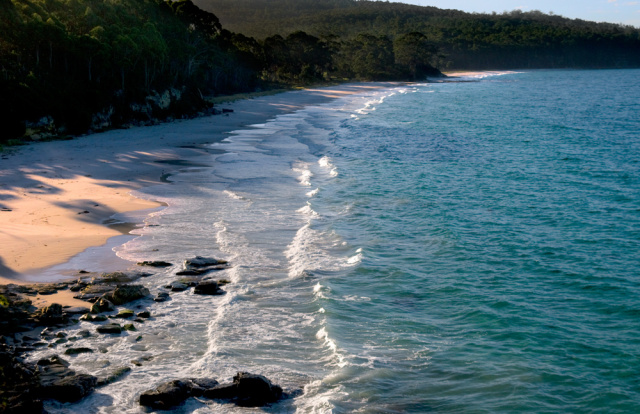
We are not separate from Nature, we are an integral part of it and protecting the environment means protecting ourselves. So connecting the island’s residents, especially the younger generation to their environment, is critical for fostering a sense of stewardship.
Our environment is a shared responsibility, and when people develop a personal connection to the land and its diverse natural inhabitants, they’re more likely to advocate for its preservation and be vigilant about its protection.
This bond transforms environmental protection from an abstract idea into a personal mission.
The urgency of this connection is underscored by the words of Greta Thunberg, who has said “I want you to act as though the house is on fire, because it is.” Her words are fierce and true. The time for action is now.

We cannot afford to wait another day, another year or another generation. Our planet is in peril and our duty is to act decisively and swiftly to safeguard its future. For Bruny Island, this means recognising that its unique ecosystems are under threat, from the diverse consequences of the climate crisis, pollution and the pressures of human activity.
To protect these ecosystems, it is imperative that the island’s residents, young and old, recognise the urgency of these issues and feel personally invested in finding the solutions.
Yet this connection isn’t just about knowledge or understanding – it’s about feeling. We must cultivate a profound emotional attachment to Nature.
When the Bruny Islanders are moved by the beauty and the importance of their surroundings and they feel the tugs of love and joy and awe and pride, they are more likely to be motivated by a form of positive local patriotism to engage in activities that support conservation efforts, and influence others that they love to do the same.
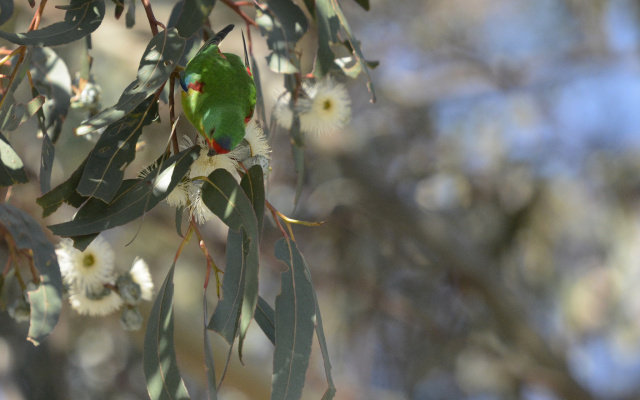
And how to make this connection?
Projects and workshops and events that get people out into the hills and valleys, forests and beaches are fantastic ways to build this bond.
It’s a bit like falling in love. You can’t just read about it, you must experience it. So let’s help people get their hands dirty and their boots muddy, their hair windblown and their hearts full.
Community involvement is another key ingredient. Planting days and clean-up events and science workshops and bird festivals can play a significant role in nurturing this connection. Coming together for shared activities not only fosters a sense of community but provides practical ways for people to feel like they are contributing to the island’s protection. When people work together towards a common goal, their commitment to that goal then strengthens.
Change can be incremental and change can be slow and change can be small, but it doesn’t matter because collective positive shifts and embedded habits can lead to wonderful outcomes.
Maybe it’s choosing a different beach to walk the dog, and maybe it’s getting home 15 minutes later than normal by driving slower and maybe it’s altering some family traditions that no longer suit today’s climates.
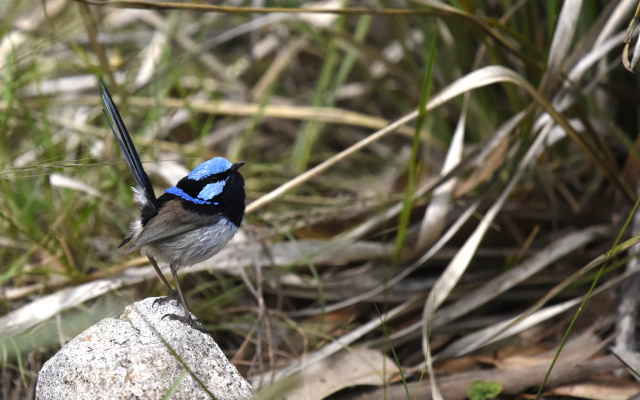
One of Kuno’s roles that I love is to showcase the importance of storytelling and all this endeavor. Community-sourced stories of Bruny Island’s cultural history, its unique species and the challenges it faces can deeply influence how people see their own environment, making global concepts and ideas become personal and immediate.
Kuno’s website can be a campfire where we can gather around and share our stories of the past and the present, warming our hands and our hearts as build an intertwined narrative of the island’s future.
To compliment these words to actions are the words of environmental poet Mary Oliver, who wrote “tell me, what is it you plan to do with your one wild and precious life?” This evocative question challenges us, to consider how we will use our time on this Earth, to make a difference.
And for Bruny Islanders its an invitation to reflect on how our lives can intertwine with the preservation of our extraordinary environment. Oliver’s words remind us that our connection to Nature is not just passive, but an act of choice that will shape out legacy.
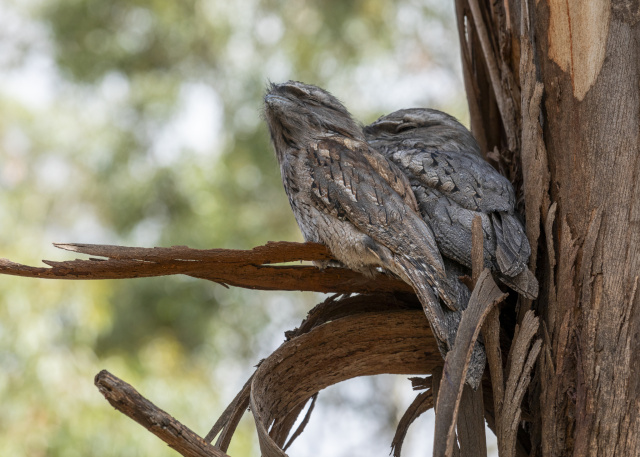
In conclusion, connecting Bruny Islanders to a love of Nature is not just a sentimental pursuit, it’s a strategic necessity for the island’s long-term protection. And with compassion and grit and humour let’s empower ourselves and the others we share this community with to become proactive stewards for this incredible island and to lay the foundation for a sustainable and protected future. And let’s never forget to celebrate the progress we have made and continue to make.
Every positive chance and every success story, every fledged forty-spotted pardalote and every weaned eastern quoll joey, every new covenanted property must fuel our collective joy, hope and determination to keep moving forward. Change can’t be achieved alone. We need each other.
We must come together as a Bruny community and as a global family to tackle these challenges before us.
So let’s embrace this challenge with passion and determination and act with the knowledge that every effort counts, every connection matters and every action we take today will shape the legacy that we leave for tomorrow.
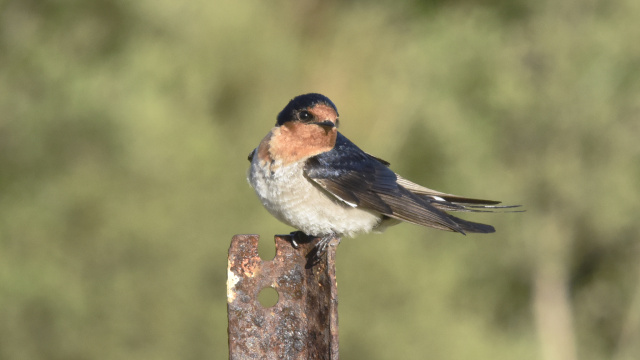
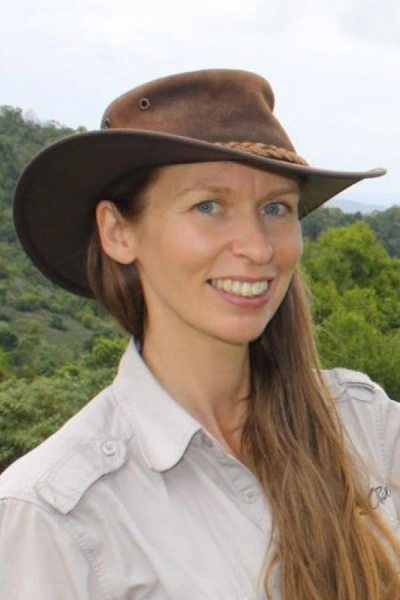
Cat Davidson
Ecology and Birding Tour Guide
Introduction by Dr Phill Pullinger, Kuno Director and CEO:
Cat grew up on the shores of Loch Ness, and from the very earliest of ages her parents ran a garden and nursery infused her with the names of a myriad of botanical plants and aspects of the natural history around her. So, as she grew up she threw herself into the outdoors and became a Nature tour guide.
When she came to Australia, she kept hearing again and again the name of Inala. So she proactively sought out Inala, which brought her here to her home on Bruny Island, where she guides tours with Inala and also across the world. She’s going to talk about the importance of connection to Nature. Thanks Cat.

Cat Davidson: It’s an honour to stand before you today to discuss an issue at the very heart of our very future – the connection between Bruny Islanders and the natural world they inhabit. Bruny Island, with its unique biodiversity, is not just a place of beauty. It’s a living testament to the resilience and fragility of Nature.
Connecting Bruny Islanders to a deep love of Nature is not merely an act of appreciation, but a crucial step towards ensuring the island’s long-term protection.
As First Lady and environmentalist, Lady Bird Johnston famously said “the environment is where we all meet. We all have a mutual interest. It is the one thing we all share.” This perspective is very relevant to Bruny Island, where every tree and every stretch of coastline and every species of wildlife is part of the delicate web of life that needs our protection.
This island’s breathtaking landscapes are not merely for our enjoyment, they are crucial to our ecological health, our physical and mental wellbeing and for many, our economic stability.

We are not separate from Nature, we are an integral part of it and protecting the environment means protecting ourselves. So connecting the island’s residents, especially the younger generation to their environment, is critical for fostering a sense of stewardship.
Our environment is a shared responsibility, and when people develop a personal connection to the land and its diverse natural inhabitants, they’re more likely to advocate for its preservation and be vigilant about its protection.
This bond transforms environmental protection from an abstract idea into a personal mission.
The urgency of this connection is underscored by the words of Greta Thunberg, who has said “I want you to act as though the house is on fire, because it is.” Her words are fierce and true. The time for action is now.

We cannot afford to wait another day, another year or another generation. Our planet is in peril and our duty is to act decisively and swiftly to safeguard its future. For Bruny Island, this means recognising that its unique ecosystems are under threat, from the diverse consequences of the climate crisis, pollution and the pressures of human activity.
To protect these ecosystems, it is imperative that the island’s residents, young and old, recognise the urgency of these issues and feel personally invested in finding the solutions.
Yet this connection isn’t just about knowledge or understanding – it’s about feeling. We must cultivate a profound emotional attachment to Nature.
When the Bruny Islanders are moved by the beauty and the importance of their surroundings and they feel the tugs of love and joy and awe and pride, they are more likely to be motivated by a form of positive local patriotism to engage in activities that support conservation efforts, and influence others that they love to do the same.

And how to make this connection?
Projects and workshops and events that get people out into the hills and valleys, forests and beaches are fantastic ways to build this bond.
It’s a bit like falling in love. You can’t just read about it, you must experience it. So let’s help people get their hands dirty and their boots muddy, their hair windblown and their hearts full.
Community involvement is another key ingredient. Planting days and clean-up events and science workshops and bird festivals can play a significant role in nurturing this connection. Coming together for shared activities not only fosters a sense of community but provides practical ways for people to feel like they are contributing to the island’s protection. When people work together towards a common goal, their commitment to that goal then strengthens.
Change can be incremental and change can be slow and change can be small, but it doesn’t matter because collective positive shifts and embedded habits can lead to wonderful outcomes.
Maybe it’s choosing a different beach to walk the dog, and maybe it’s getting home 15 minutes later than normal by driving slower and maybe it’s altering some family traditions that no longer suit today’s climates.

One of Kuno’s roles that I love is to showcase the importance of storytelling and all this endeavor. Community-sourced stories of Bruny Island’s cultural history, its unique species and the challenges it faces can deeply influence how people see their own environment, making global concepts and ideas become personal and immediate.
Kuno’s website can be a campfire where we can gather around and share our stories of the past and the present, warming our hands and our hearts as build an intertwined narrative of the island’s future.
To compliment these words to actions are the words of environmental poet Mary Oliver, who wrote “tell me, what is it you plan to do with your one wild and precious life?” This evocative question challenges us, to consider how we will use our time on this Earth, to make a difference.
And for Bruny Islanders its an invitation to reflect on how our lives can intertwine with the preservation of our extraordinary environment. Oliver’s words remind us that our connection to Nature is not just passive, but an act of choice that will shape out legacy.

In conclusion, connecting Bruny Islanders to a love of Nature is not just a sentimental pursuit, it’s a strategic necessity for the island’s long-term protection. And with compassion and grit and humour let’s empower ourselves and the others we share this community with to become proactive stewards for this incredible island and to lay the foundation for a sustainable and protected future. And let’s never forget to celebrate the progress we have made and continue to make.
Every positive chance and every success story, every fledged forty-spotted pardalote and every weaned eastern quoll joey, every new covenanted property must fuel our collective joy, hope and determination to keep moving forward. Change can’t be achieved alone. We need each other.
We must come together as a Bruny community and as a global family to tackle these challenges before us.
So let’s embrace this challenge with passion and determination and act with the knowledge that every effort counts, every connection matters and every action we take today will shape the legacy that we leave for tomorrow.

You might like...

Bruny Island launch: CEO Phill Pullinger on the Kuno concept

Bruny Island launch: Dr Tonia Cochran on its global significance

Bruny Island launch: Bob Graham on the hidden world behind the photos

Bruny Island nesting box project
Newsletter
Sign up to keep in touch with articles, updates, events or news from Kuno, your platform for nature
